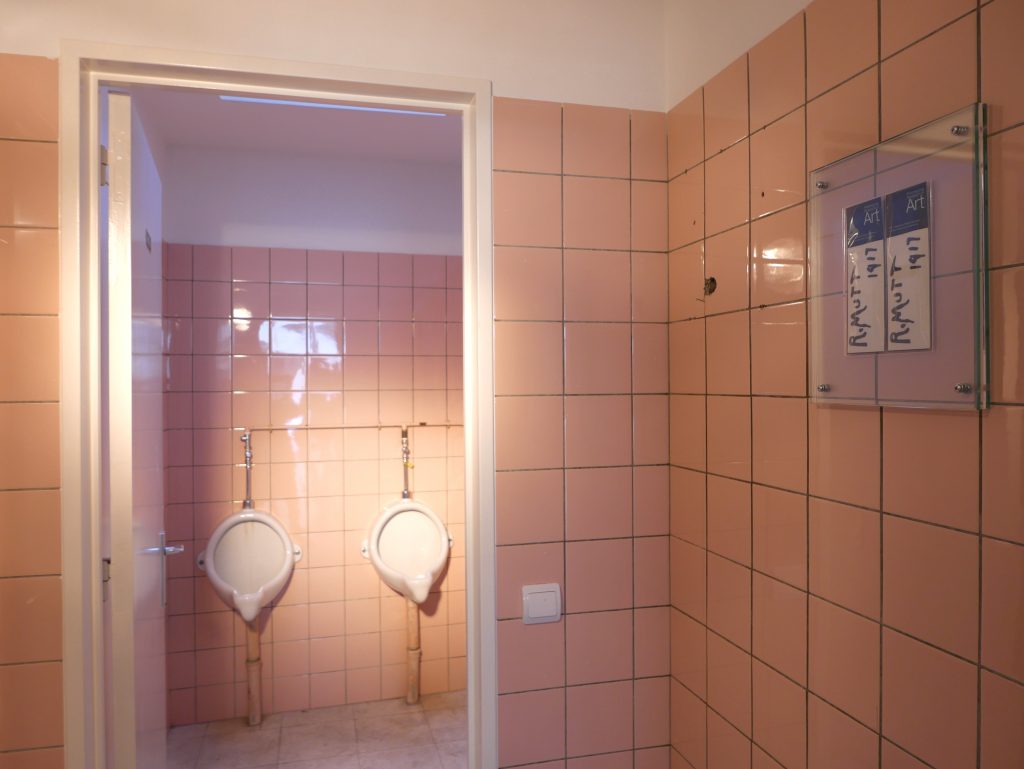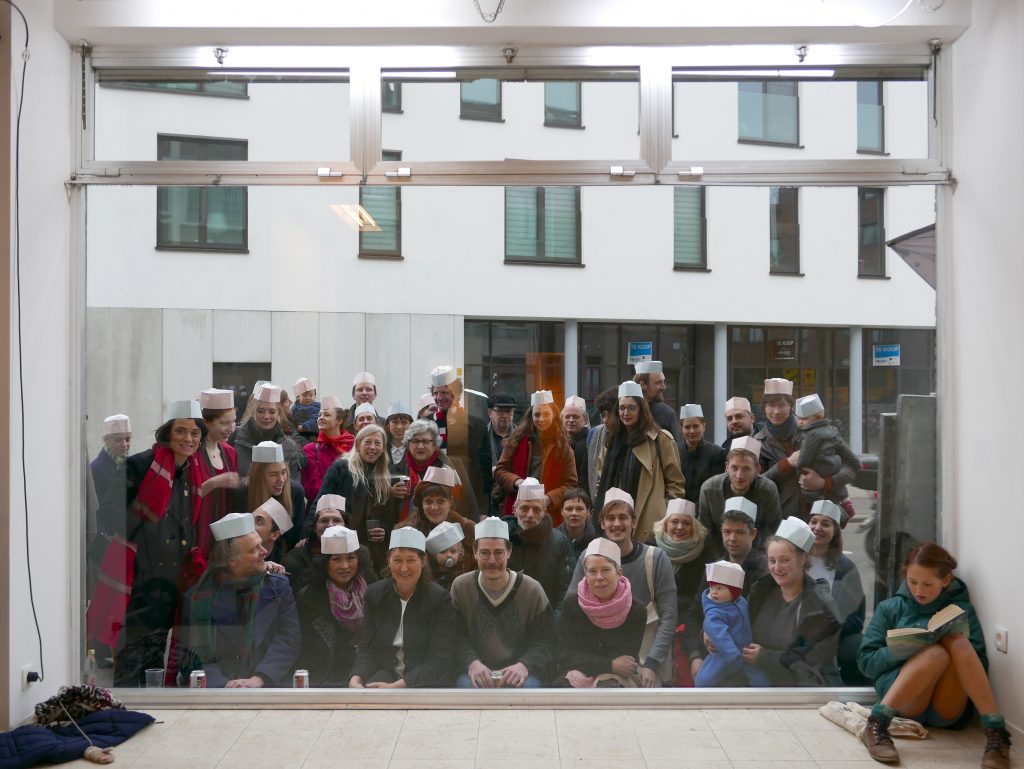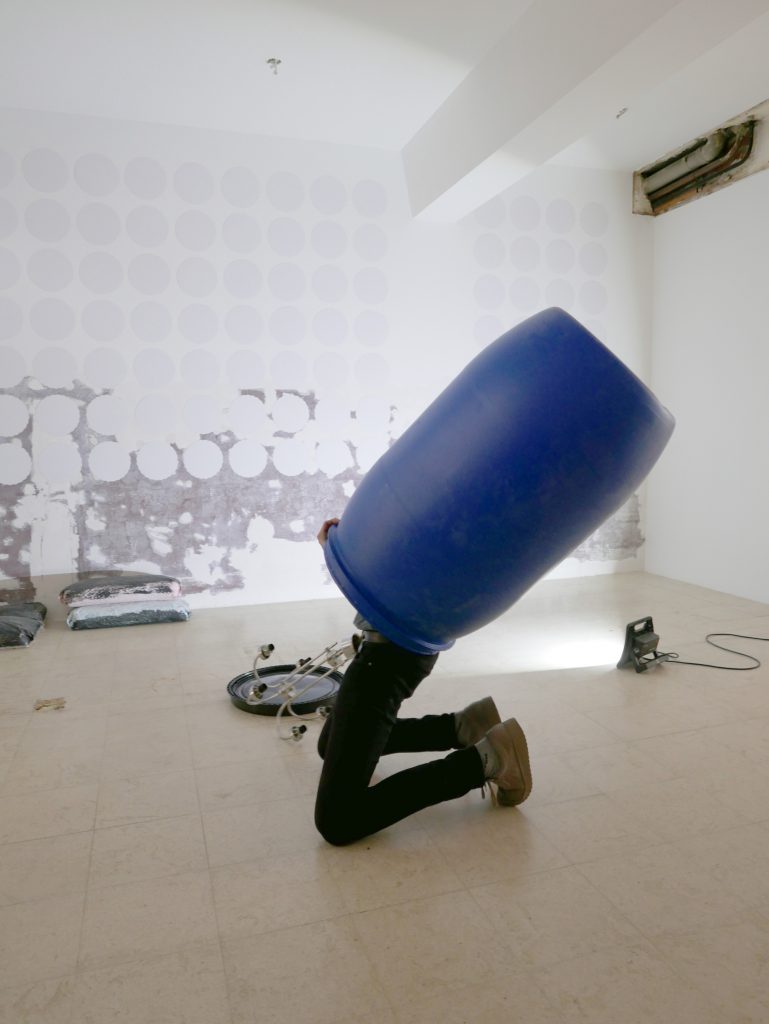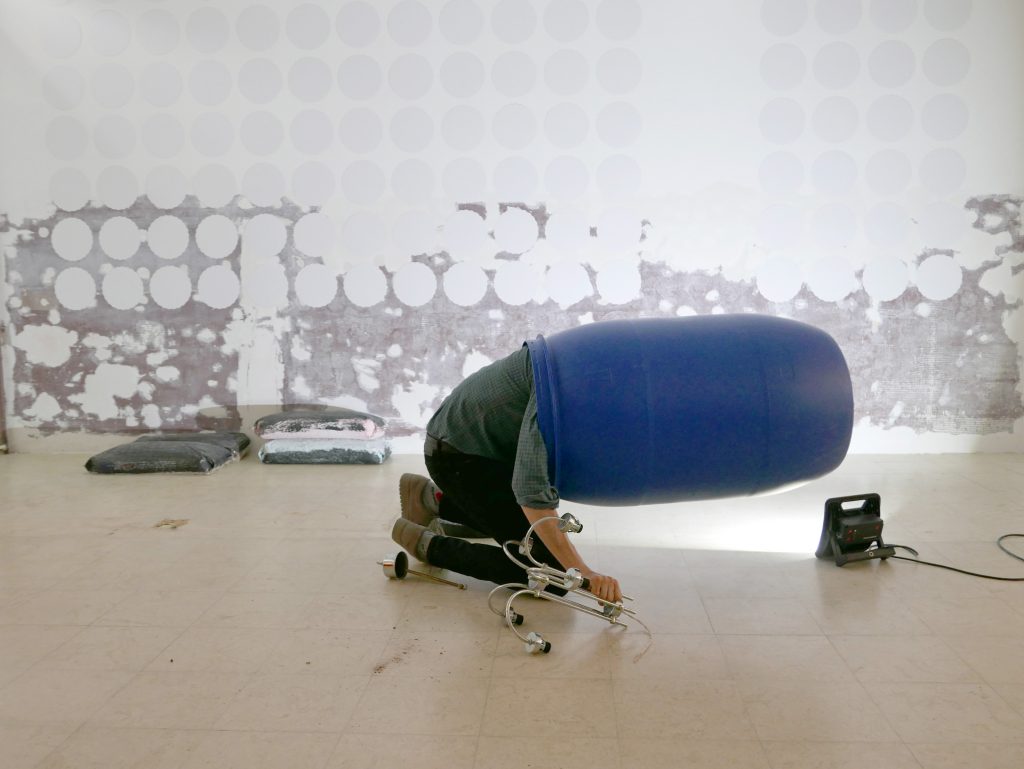Joëlle Tuerlinckx
FOR
04.03.2018 — 22.04.2018
[NL]
JOËLLE TUERLINCKX / FOR / LLS PALEIS
il commence par un changement de direction : la porte d’entrée s’ouvre à gauche.
Tuerlinckx kijkt met een onbevooroordeelde blik naar de ruimte, en sondeert.
De geschiedenis, associaties, de woordenschat die ermee verbonden wordt (ook fonetisch) trekt haar aandacht. Kortom, ze peilt en ze stelt vast:
De locatie huisvestte vroeger een frituur, een handelsruimte, “un commerce”; dit is een uitgangspunt. Ze heet nu LLS Paleis omwille van haar geografische ligging (Paleisstraat), maar dàn springen tal van eigenaardige decoratieve elementen in het oog die deze associatie bij Tuerlinckx stimuleren: Een ruimte die paleis wil zijn: er zijn sterretjes aan het plafond, zilveren ventilatoren, betegeling, het sanitair,… En tot slot de huidige functie van de plaats: een kunstruimte.
Deze drie aspecten verwijzen naar elkaar, raken elkaar, vermengen zich op verschillende wijzen. Zonder hiërarchie. Het verleden, het heden en het toekomstige … worden als evenwaardig tentoongesteld.
Vele van de decoratieve elementen waren al in twee- of meervoud aanwezig. Een aanleiding om een inventaris op te stellen en te (ver)tellen.
Meteen aan de ingang hangen lijsten met het inventaris van wat in de ruimte aanwezig is. Zij refereren aan de economische activiteit van vroeger. Op de inventarislijsten vinden we de woordenschat terug uit een economie die hoeveelheden meet: liters, kilo, lot, netto, bruto, tarra, units, … Zelfs cm en mm en vreemd genoeg blijkt de taal van de beeldende kunst niet ver weg te zijn.
Daarnaast rechts het artefact, het prototype dat in een vitrine tentoongesteld wordt en de kunstwereld oproept. Een gesloten zak uit China, met een stempeldruk in het Chinees, een zak die Tuerlinckx uit een vorige tentoonstelling naar België heeft overgebracht zonder tot op heden te weten wat erin zit. In de kunst spreekt men over unicaat, origineel, maar ook over oplage, editie, … De confrontatie tussen deze werelden is een onderwerp dat Tuerlinckx fascineert: China roept het beeld van de economie op, de vitrine dat van de museumwereld. Hier spiegelen beide werelden elkaar.
Elk werk van Tuerlinckx gaat eigenlijk over een begin. LLS Paleis inhuldigend toont Tuerlinckx ons het potentieel van de plaats, de mogelijkheid een deel van een tentoonstelling verder te laten lopen dan de aangekondigde sluitingsdatum, of om een beginnend project verder te zetten. Een krant die nr. 1 draagt, suggereert een nr. 2.
Deze tentoonstelling is eigenlijk een tonen van een stilstaand moment van wat de activiteit van Tuerlinckx is: zij nummert, klasseert, inventariseert, maakt lijsten, voegt toe, neemt weg, etc.
En wacht het goede moment af.
In het mannentoilet toont ze de urinoir van Duchamp aan, hier in tweevoud. Een vreemd toeval is dat zij een jaar geleden in de museumshop van het Museum of Art in Philadelphia twee stickers R. Mutt 2017 kocht. Het dubbele verschijnt als een emblematische figuur in deze tentoonstelling, het duo wordt een leidmotief: twee ventilatoren, twee deuren, twee neons, … Daarnaast (h)erkent Tuerlinckx het “koppel” blauw-roze, een wederkerend koppel in haar eigen oeuvre.
In de voormalige koelruimte plaatst zij enkele briks Ayran, gekocht bij de Turkse winkel om de hoek. Globalisatie en lokale handel komen samen, zoals ook de idee van massaproductie en kunst. Het voorbeeld hangt in het sanitair, de signatuur “R. Mutt” is nu een massaproduct.
De blauwe zaal toont het grote volume DAGBLAD N°1 LLS Paleis Papers, een eerste resultaat van een project in oplage per pagina geconcipieerd. En aan de muur, een postkaart van het Museum Plantin Moretus: de Proeflezerskamer.
Op het dak wordt een politiek en ecologisch standpunt ingenomen tegen de monocultuur van de smaken en de verarming van de zaden: Het organiseren van een eigen parallel circuit met als doel verschillende variëteiten te laten groeien en voortbestaan is eveneens een deel van de tentoonstelling. Aldus kan de dubbele o op de uitnodigingskaart van FOR ontrafeld worden: achterstevoren gelezen ROOF. Op het gelijkvloers de eigenheid van de ruimte (‘Floor Nature’), op het dak: het kweken van de aardappelen (‘Roof Culture’). Een elitaire of populaire cultuur?
De uitnodigingskaart imiteert een seriële mailing eigen aan firma’s en groothandels die potentiële klanten willen bereiken. De gepersonaliseerde catalogi zouden insinueren dat er een persoonlijke relatie is, maar de industriële onverschilligheid laat zich niet camoufleren.
In FOR zien we het ontmoetingsmoment tussen restauratie-activiteit (zowel van frituuruitbaters als van restauratoren) en seriële kunst, pop-art, conceptuele kunst, het tonen van objecten en het aanbrengen van decoratieve elementen als een humoristische toevoeging in een ruimte die nog tal van sporen van een werf draagt, maar verlangt uitzonderlijk te zijn…
Stella Lohaus
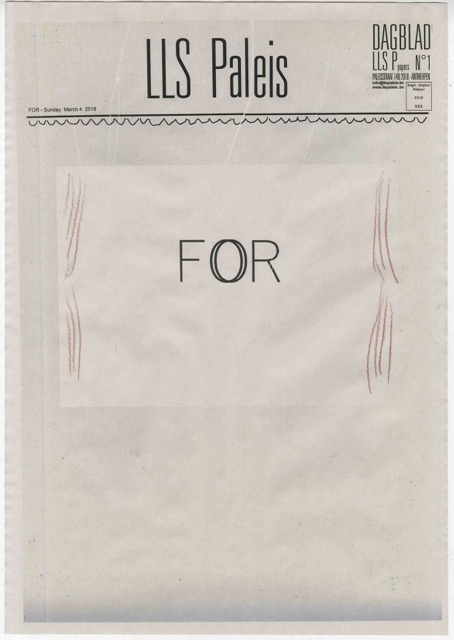
[FR]
JOËLLE TUERLINCKX/ FOR/LLS PALEIS
il commence par un changement de direction : la porte d’entrée s’ouvre à gauche.
Tuerlinckx appréhende l’espace avec un regard sans préjugé, elle le sonde. Son attention est attirée par l’histoire du lieu, puis elle crée des associations, parfois même purement phonétiques. En bref, elle mesure et elle constate.
Le local était antérieurement une friterie, un espace commercial, “un commerce”, ceci est un point de départ. À présent il s’appelle LLS Paleis (LLS Palais), grâce à sa localisation géographique. Tuerlinckx y découvre une multitude d’éléments
décoratifs qui stimulent cette association (un espace qui veut être palais) : des étoiles au plafond, des ventilateurs, du carrelage, l’équipement des sanitaires… Et puis elle envisage aussi la fonction actuelle de l’endroit : un espace d’art. Elle se concentre sur ces trois aspects référentiels et les intègre, les mixe de différentes manières. Sans aucune hiérarchie.
Le passé, le présent et ‘la future…’ sont exposés, sur un pied d’égalité.
Beaucoup d’éléments décoratifs de l’état antérieur sont déjà présents, en double ou en nombre. C’est une occasion de composer, de raconter, de conter et de compter, de constituer un inventaire. Dès l’entrée se trouvent des listes qui répertorient tous les ingrédients trouvés et exposés sur place. Elles font référence à l’ancienne activité économique, par le vocabulaire qui reprend des unités de mesure : Litre, Kilo, Lot, Nette, Brut, Tarra, Unités… mais aussi cm, mm, et étrangement le langage de l’art n’est pas très loin.
Ensuite, sur la droite, un prototype est exposé dans une vitrine évoquant le monde de l’art. Un sac fermé d’origine chinoise, qui porte l’impression d’un timbre en Chinois, un sac que Tuerlinckx a transporté en Belgique sans en connaître le contenu jusqu’à ce jour. Dans l’art on a coutume d’opposer l’exemplaire unique, l’original, au multiple, à l’édition, une distinction qui est un objet de fascination central pour Tuerlinckx. Elle confronte aussi la Chine, associée à l’économie, à la vitrine, qui évoque le musée. Deux mondes se reflètent, dans un effet miroirique.
Toute œuvre de Tuerlinckx, au fond, traite d’un commencement. En inaugurant LLS Paleis, Tuerlinckx nous montre le potentiel du lieu, les possibilités de continuer un aspect de l’exposition au delà de la date de clôture, ainsi de poursuivre un projet initié. Le N° 1 appelle au N° 2.
Ainsi, l’exposition peut être comprise comme un moment arrêté dans l’activité de Tuerlinckx, qui énumère, classifie, inventorie, liste, retire et rajoute… Elle attend le bon moment.
Dans les WC hommes, elle pointe l’urinoir de Duchamp, ici double. Curieuse coïncidence : il y a un an, elle achetait à la boutique du Musée d’Art de Philadelphie le double autocollant R. Mutt 1917… Le double apparaît comme une figure emblématique de cette exposition, le duo s’installe comme leitmotiv : deux ventilateurs, deux portes, deux néons… Au delà des urinoirs, elle reconnait le “couple” rose et bleu, ce couple récurrent dans son propre travail.
Dans la chambre froide, elle place quelques ‘briques’ Ayran (emballage fin de lot) achetées dans le magasin turc du coin. Globalisation et commerce local se rencontrent, tout comme la production de masse et l’art. L’exemple envisagé, avec la référence à l’urinoir de R. Mutt, est un produit de masse.
La salle bleue montre le grand volume DAGBLAD LLS Paleis Papers N° 1, une première épreuve du projet d’édition conçu à la page. Et sur le mur : une carte postale du Musée Plantin Moretus : La Grande Librairie, La chambre des Correcteurs.
Une position se dégage, qui va à l’encontre de la monoculture des goûts et de l’appauvrissement des graines ; l’organisation d’un circuit parallèle personnel, qui a pour objectif de laisser pousser et survivre diverses variétés, fait également partie de l’exposition. C’est ainsi que le double o de FOR peut être interprété : ROOF lu en sens inverse. ‘Floor Nature’ au rez-de-chaussée de l’espace d’exposition, ‘Roof Culture’ et la culture de pommes de terre sur le toit. Une culture élitaire ou populaire?
Le carton d’invitation imite les mailings sériels propres aux firmes et grandes marques soucieuses d’atteindre des clients potentiels. Les catalogues personnalisés semblent insinuer qu’une relation individuelle existe, mais l’indifférence industrielle ne parvient pas à se dissimuler.
Avec l’exposition FOR, on assiste à un moment de rencontre entre la (petite) restauration et l’art sériel, le Pop art, l’art conceptuel. L’étalage des objets et l’accrochage des éléments décoratifs se présentent comme une addition humoristique dans un dispositif qui garde toujours les traces d’un chantier, mais dans un désir d’être exceptionnel…
Stella Lohaus
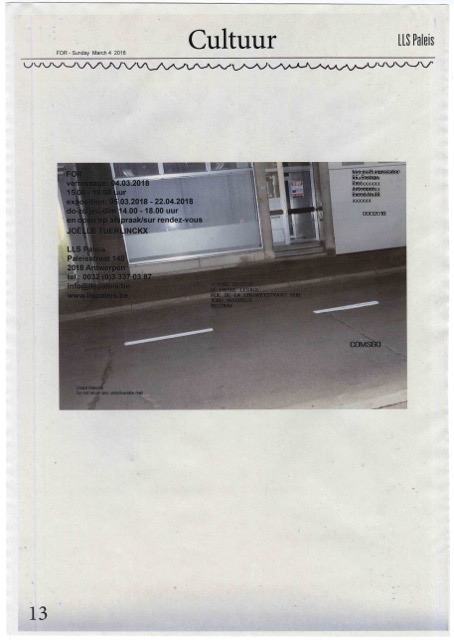
[EN]
JOËLLE TUERLINCKX / FOR / LLS PALEIS
il commence par un changement de direction : la porte d’entrée s’ouvre à gauche.
Tuerlinckx looks at space with an unbiased view, and probes.
The history, associations, vocabulary connected to it (also phonetically) draw her attention. In short, she gauges and establishes:
The location used to be a chip shop (French fries), a commercial space, “un commerce”, this is a starting point. It is now called LLS Paleis (palace) because of its geographical position (Paleisstraat), but then several strange decorative elements catch the eye of Tuerlinckx, stimulating this association. A space that wants to be a palace: there are stars on the ceiling, silver fans, tiling, the plumbing,… And on top of that its current function: an art space.
These three aspects mutually influence each other, refer to each other, touch each other, mix in different ways. Without hierarchy. The past, present and “the upcoming” are represented on equal terms.
Many of the decorative elements were already present in twofold or in plural. A reason to make and (re)count an inventory.
At the entrance one immediately finds lists with the inventory of what is present in the space. They refer to the economical activity from the past. On the inventory lists, we can see the vocabulary of an economy that measures quantities: liters, kilo, lot, net, gross, tare, units,… Cm and mm as well, and strangely enough, the language of visual art seems not far-off.
On the right side, the artifact, the prototype which is on display in a showcase and evokes the art world. A sealed bag from China, with a stamp in Chinese, a bag from a previous exhibition brought to Belgium by Tuerlinckx, who to this day does not know what’s inside. In the world of art, people talk about unique work, original, but also about multiple, edition,… The confrontation between these worlds constitutes a subject Tuerlinckx finds fascinating: China evokes the image of economy, a showcase the museum world. Here, both worlds mirror each other.
Each work by Tuerlinckx is really about a beginning.
By inaugurating LLS Paleis, Tuerlinckx shows us the potential of the space, the possibility of having the exhibition exceed the announced closing date or continuing a beginning project. A paper numbered n°1, seems to anticipate a future n°2.
The exhibition shows in fact a still moment of what Tuerlinckx’ activity really is: she numbers, classifies, inventories, makes lists, removes, adds, etc.
And waits for the right moment.
In the men’s room, she indicates Duchamp’s urinal, in twofold here. By some strange coincidence, last year at the museum shop of the Museum of Art in Philadelphia, she bought two R. Mutt 2017 stickers. Doubleness appears as an emblematic figure throughout this exhibition, duos become a leitmotif: two fans, two doors, two neons,… On top of that, Tuerlinckx recognizes the ‘couple’ blue-pink, a returning couple in her own oeuvre.
In the old cold chamber, she places some Ayran brigs bought at the local Turkish shop around the corner. Globalisation and local trade meet, as do the idea of mass production and art. The example hangs in the lavatory, the “R. Mutt” signature is now a mass product.
In the blue room, the big volume DAGBLAD N°1 LLS Paleis Papers is displayed, a first result of a project conceived in print per page. And on the wall, a postcard from the Museum Plantin Moretus: the Proofreading Room.
On the roof, a political and ecological stand is taken against the mono-culture of tastes and the impoverishment of seeds: the organization of an personal parallel circuit with a view to growing and subsisting different varieties is also part of the exhibition. This way, the double ‘o’ on the invitation card of the FOR exhibition can be figured out: ROOF read backwards. On the floor, the individuality of the space (“Floor Nature”), on the roof: cultivation of potatoes (“Roof Culture”). An elitist, or a popular culture?
The invitation card imitates a serial mailing proper to firms and retailers trying to reach potential customers. The personalized catalogs seem to imply a personal relationship, but the industrial indifference cannot be camouflaged.
In FOR, we see the moment of encounter between conservation activity (from chip shop owners as well as conservators) and serial art, pop-art, conceptual art, showing objects and adding decorative elements as a humorous addition to a space which still shows many traces of a wharf, yet longs to be exceptional…
Stella Lohaus
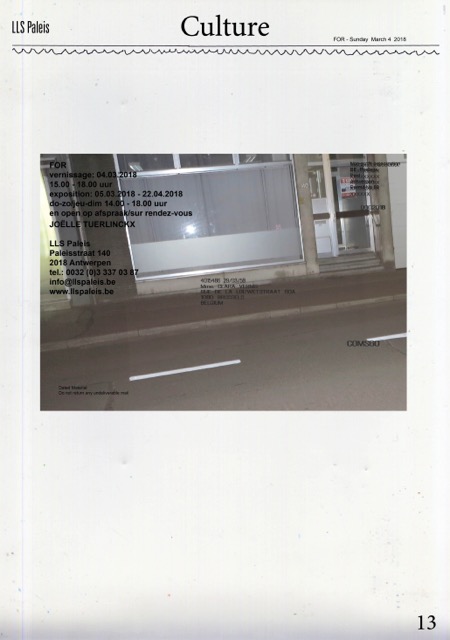
During the finissage on 22 April 2018, Joëlle Tuerlinckx presented the edition project LLS P:
transformation of the entire exhibited LLS P Papers of 4 March, completed 22 April to a newspaper: the DAGBLAD N°1. Daniel Dariel performed “KOHLHYDRA10”.
With the support of the Flemish Government and the City of Antwerp.
Sponsored by Duvel Moortgat and Sampa Tea Company.
With thanks to Gilles Baeyens, Nadia Bijl, Dora Brams, Liska Brams, Elias Cafmeyer, Kris Cuylits, Daniel Dariel, Bram Denkens, Maria Dietrich, Christoph Fink, Ward Heirwegh, Oscar Hugal, Hannelore Mattheus, Kathy Moyson, Ria Pacquée, Victor Rochette, Bart Ruysschaert, Sarah Smolders, Juliette Thomas, Rudy Van Campenhout, Jivan van der Ende and Begga Vermaelen
More
Devriendt, Indra: “Wat was, is en zal zijn”. In <H> art. 22 maart 2018, Nr. 179, p.10.







